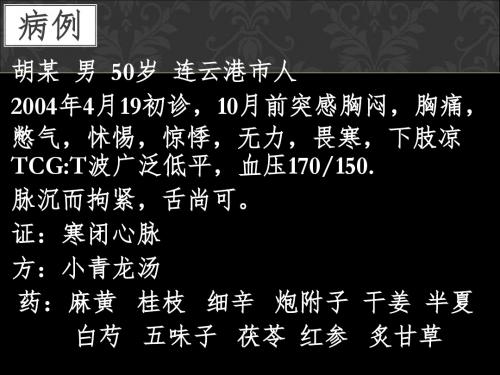动脉粥样硬化和高血压PPT课件
合集下载
《营养与疾病》PPT课件

反映
关系密切
脂代谢紊乱
动脉粥样硬化
影响
膳食和营养因素
血脂变化
控制
(三)膳食脂类与动脉粥样硬化
1、饱和脂肪酸
<10C、>18C
不升高血胆固醇
16C、14C、12C
升高血胆固醇
(三)膳食脂类与动脉粥样硬化
2、单不饱和脂肪酸 Eg:橄榄油、茶油
总TG、LDL
3、多不饱和脂肪酸 n-6(eg:亚油酸) n-3(eg:亚麻酸)
第一节 第二节 第三节 第四节
肥胖症 营养与心血管疾病 营养与糖尿病 营养与肿瘤
第二节 营养与心血管疾病
一、营养与动脉粥样硬化 二、营养与高血压
一、营养与动脉粥样硬化
(一)血浆中的脂类和蛋白质
(二)高脂血症和高脂蛋白血症
(三)膳食脂类与动脉粥样硬化
(四)膳食能量、碳水化合物
脉粥样硬化
与动
(五)蛋白质与动脉粥样硬化
(八)营养防治原则
1、控制总能量摄入,保持理想体重 2、限制脂肪和胆固醇摄入 3、提高植物性蛋白的摄入 4、保证充足的膳食纤维摄入 5、供给充足的维生素和矿物质 6、饮食清淡,少盐少酒 7、适当多吃保护性食物
二、营养与高血压
(一)营养因素对原发性高血压的影响 (二)原发性高血压的营养防治
(一)营养因素对原发性高血压的影响
(六)维生素和微量元素与动脉粥样硬化
(七)其他因素
动脉粥样硬化
是一种炎症性、多阶段的退行性复合性 疾病。 导致受损的动脉壁增厚变硬、失去弹性、管腔缩小。
动脉粥样硬化
冠心病
动脉粥样形成的原因
遗传 年龄 肥胖 吸烟 缺乏体力活动 营养膳食因素:极为重要
(一)血浆中的脂类和脂蛋白
动脉粥样硬化PPT医学课件

合理饮食 适量运动 戒烟限酒
控制血糖和血脂
保持低脂、低盐、高纤维的饮食 ,控制体重,避免过度肥胖。
戒烟并限制酒精摄入,以减少对 血管的损害。
药物治疗
抗血小板药物
如阿司匹林、氯吡格雷等 ,可以防止血小板聚集, 预防血栓形成。
降血脂药物
如他汀类药物,可以降低 血脂水平,减少血管内的 炎症反应。
降压药物
动脉粥样硬化ppt医学课件
2023-11-11
目录
• 动脉粥样硬化概述 • 动脉粥样硬化的病理生理学 • 动脉粥样硬化的影响因素 • 动脉粥样硬化的预防和治疗 • 动脉粥样硬化与心血管疾病 • 动脉粥样硬化与脑血管疾病 • 动脉粥样硬化与外周血管疾病
01
动脉粥样硬化概述
Chapter
定义和分类
治疗
血运重建治疗(如经皮冠状动脉介入治疗、溶栓治疗等)、抗血小板 治疗等。
06
动脉粥样硬化与脑血管疾病
Chapter
脑梗死
定义
脑梗死是指由于脑部血管堵塞, 导致脑部供血不足,引起脑细胞 死亡的疾病。
症状
脑梗死的症状包括头痛、眩晕、 肢体麻木、无力、口齿不清等。
01 02 03 04
原因
脑梗死的主要原因是动脉粥样硬 化,其他原因包括血栓形成、栓 塞等。
07
动脉粥样硬化与外周血管疾病
Chapter
下肢动脉硬化闭塞症
1 2
症状
早期可无明显症状,随后出现间歇性跛行,随着 病情进展可出现静息痛、溃疡、坏疽等症状。
诊断
通过体格检查、超声、CTA等检查手段进行诊断 。
3
治疗
以手术治疗为主,包括内膜剥脱术、搭桥手术等 。
肾动脉粥样硬化
2024版高血压ppt课件完整版

心脑血管事件风险。
调整血脂
合理使用他汀类药物,降低胆固 醇和甘油三酯水平,预防动脉粥 样硬化。
抗血小板治疗
对于高危患者,可考虑使用阿司 匹林等抗血小板药物,减少血栓 形成机会。
定期筛查
定期进行心电图、超声心动图等 检查,及时发现并处理心脑血管
并发症。
肾脏保护措施及实施方法
控制血压
保持血压稳定,避免肾 脏损害加重。
及时沟通反馈
家属应与医生保持沟通,及时反馈患者的病 情变化和治疗反应。
06
最新研究进展及未来趋 势
新型降压药物研发动态
肾素抑制剂
通过抑制肾素活性,降低血管紧张素原生成,从而有效降低血压。
血管内皮保护剂
能够保护血管内皮细胞,减少血管损伤和炎症反应,降低高血压并 发症风险。
复合制剂
针对多种高血压发病机制,将不同作用机制的药物组合在一起,提 高降压效果和患者依从性。
分类
根据血压升高的水平,高血压可分为1级、2级和3级。此外, 根据合并症及靶器官损害情况,还可分为低危、中危、高危和 极高危等不同层次。
发病原因及危险因素
发病原因
高血压的发病原因包括遗传因素、环 境因素、生活习惯因素、药物因素等。 其中,遗传因素和环境因素是主要的 发病原因。
危险因素
高血压的危险因素包括高盐饮食、肥胖、 缺乏运动、过量饮酒、长期精神紧张等。 这些危险因素可单独或共同作用于人体, 导致血压升高。
02
03
肾小动脉硬化
高血压导致肾入球小动脉 硬化,肾小球滤过率下降, 肾功能减退。
肾实质损害
长期高血压可引起肾实质 缺血、萎缩,导致肾衰竭。
肾功能不全
高血压与肾脏疾病相互影 响,形成恶性循环,加重 肾功能损害。
调整血脂
合理使用他汀类药物,降低胆固 醇和甘油三酯水平,预防动脉粥 样硬化。
抗血小板治疗
对于高危患者,可考虑使用阿司 匹林等抗血小板药物,减少血栓 形成机会。
定期筛查
定期进行心电图、超声心动图等 检查,及时发现并处理心脑血管
并发症。
肾脏保护措施及实施方法
控制血压
保持血压稳定,避免肾 脏损害加重。
及时沟通反馈
家属应与医生保持沟通,及时反馈患者的病 情变化和治疗反应。
06
最新研究进展及未来趋 势
新型降压药物研发动态
肾素抑制剂
通过抑制肾素活性,降低血管紧张素原生成,从而有效降低血压。
血管内皮保护剂
能够保护血管内皮细胞,减少血管损伤和炎症反应,降低高血压并 发症风险。
复合制剂
针对多种高血压发病机制,将不同作用机制的药物组合在一起,提 高降压效果和患者依从性。
分类
根据血压升高的水平,高血压可分为1级、2级和3级。此外, 根据合并症及靶器官损害情况,还可分为低危、中危、高危和 极高危等不同层次。
发病原因及危险因素
发病原因
高血压的发病原因包括遗传因素、环 境因素、生活习惯因素、药物因素等。 其中,遗传因素和环境因素是主要的 发病原因。
危险因素
高血压的危险因素包括高盐饮食、肥胖、 缺乏运动、过量饮酒、长期精神紧张等。 这些危险因素可单独或共同作用于人体, 导致血压升高。
02
03
肾小动脉硬化
高血压导致肾入球小动脉 硬化,肾小球滤过率下降, 肾功能减退。
肾实质损害
长期高血压可引起肾实质 缺血、萎缩,导致肾衰竭。
肾功能不全
高血压与肾脏疾病相互影 响,形成恶性循环,加重 肾功能损害。
2024年度高血压疾病PPT课件

高血压是脑血管意外的重要危险 因素,可导致脑出血、脑梗死等
严重后果。
2024/2/3
认知功能障碍
长期高血压可影响大脑认知功能, 表现为注意力不集中、记忆力减退 等。
自主神经功能紊乱
高血压可引起交感神经兴奋,表现 为心悸、失眠、多汗等症状。
11
其他器官受累表现
视网膜病变
高血压可导致视网膜小动脉硬化 、渗出、出血等病变,严重时可
和评估的基础。
体格检查
02
包括身高、体重、腰围、臀围等测量,评估患者肥胖程度和靶
器官损害情况。
实验室检查
03
包括血常规、尿常规、生化检查等,有助于了解患者肝肾功能
、血脂血糖等代谢指标。
14
靶器官损害评估指标
心电图和超声心动图
评估心脏结构和功能,检测左 心室肥厚、冠心病等心脏并发
症。
2024/2/3
避免使用对肾脏有损害的药物,如某些抗生素、 解热镇痛药等。
2024/2/3
24
视网膜脱落等眼部并发症处理建议
定期眼科检查
高血压患者应定期进行眼科检查,及时发现并处理眼部并发症。
控制血压
稳定控制血压,减少血压波动对眼部血管的损伤。
2024/2/3
激光治疗
对于严重的视网膜病变,可考虑激光治疗,封闭出血点,减少渗出 。
高血压疾病PPT课件
2024/2/3
1
目 录
2024/2/3
• 高血压疾病概述 • 高血压病理生理机制 • 高血压检查方法与评估指标 • 高血压治疗原则与药物选择 • 高血压并发症预防与处理策略 • 患者教育与日常生活管理建议
2
01
高血压疾病概述
2024/2/3
严重后果。
2024/2/3
认知功能障碍
长期高血压可影响大脑认知功能, 表现为注意力不集中、记忆力减退 等。
自主神经功能紊乱
高血压可引起交感神经兴奋,表现 为心悸、失眠、多汗等症状。
11
其他器官受累表现
视网膜病变
高血压可导致视网膜小动脉硬化 、渗出、出血等病变,严重时可
和评估的基础。
体格检查
02
包括身高、体重、腰围、臀围等测量,评估患者肥胖程度和靶
器官损害情况。
实验室检查
03
包括血常规、尿常规、生化检查等,有助于了解患者肝肾功能
、血脂血糖等代谢指标。
14
靶器官损害评估指标
心电图和超声心动图
评估心脏结构和功能,检测左 心室肥厚、冠心病等心脏并发
症。
2024/2/3
避免使用对肾脏有损害的药物,如某些抗生素、 解热镇痛药等。
2024/2/3
24
视网膜脱落等眼部并发症处理建议
定期眼科检查
高血压患者应定期进行眼科检查,及时发现并处理眼部并发症。
控制血压
稳定控制血压,减少血压波动对眼部血管的损伤。
2024/2/3
激光治疗
对于严重的视网膜病变,可考虑激光治疗,封闭出血点,减少渗出 。
高血压疾病PPT课件
2024/2/3
1
目 录
2024/2/3
• 高血压疾病概述 • 高血压病理生理机制 • 高血压检查方法与评估指标 • 高血压治疗原则与药物选择 • 高血压并发症预防与处理策略 • 患者教育与日常生活管理建议
2
01
高血压疾病概述
2024/2/3
冠状动脉粥样硬化PPT课件

特点
冠状动脉粥样硬化通常在成年后 开始,随着年龄增长而加重,男 性发病率高于女性。
发病机制
脂质代谢异常
血液中低密度脂蛋白(LDL)和 总胆固醇升高,高密度脂蛋白
(HDL)降低,导致脂质在冠状 动脉壁沉积。
内皮细胞损伤
各种危险因素如高血压、糖尿病、 吸烟等可损伤冠状动脉内皮细胞, 导致炎症反应和粥样斑块形成。
左上肢。
心肌梗死
严重的心绞痛发作可能导致心肌 梗死,表现为持续的严重胸痛、 出汗、呼吸困难等,严重时可导 致心律失常、低血压甚至休克。
心力衰竭
长期心肌缺血可导致心脏功能受 损,引发心力衰竭。心力衰竭时 可能出现呼吸困难、乏力、液体
潴留等症状。
诊断方法
心电图
心电图是初步评估心脏电活动的常用方法,有助于发现心肌缺血 或心律失常。
动脉粥样硬化的形成与进展
动脉粥样硬化是一种慢性炎症性 疾病,其特点是动脉壁上沉积脂 肪、钙和其他物质,形成斑块。
随着时间的推移,这些斑块会逐 渐增大,导致动脉管腔狭窄,血
流受阻。
动脉粥样硬化的进展速度因人而 异,取决于多种因素,包括遗传、
生活方式和环境因素等。
冠状动脉粥样硬化的病理特点
冠状动脉粥样硬化斑块主要由脂质核 心和纤维帽组成。
戒烟限酒
戒烟和限制酒精摄入有助于保 护心血管健康。
健康的生活方式
01
02
03
均衡饮食
多摄入蔬菜水果、全谷类、 低脂肪乳制品,减少饱和 脂肪和反式脂肪的摄入。
适量运动
每周至少进行150分钟的 中等强度有氧运动,如快 走、骑车、游泳等。
保持心理健康
减轻压力、学会放松技巧、 保持良好的人际关系,有 助于降低心血管疾病的风 险。
冠状动脉粥样硬化通常在成年后 开始,随着年龄增长而加重,男 性发病率高于女性。
发病机制
脂质代谢异常
血液中低密度脂蛋白(LDL)和 总胆固醇升高,高密度脂蛋白
(HDL)降低,导致脂质在冠状 动脉壁沉积。
内皮细胞损伤
各种危险因素如高血压、糖尿病、 吸烟等可损伤冠状动脉内皮细胞, 导致炎症反应和粥样斑块形成。
左上肢。
心肌梗死
严重的心绞痛发作可能导致心肌 梗死,表现为持续的严重胸痛、 出汗、呼吸困难等,严重时可导 致心律失常、低血压甚至休克。
心力衰竭
长期心肌缺血可导致心脏功能受 损,引发心力衰竭。心力衰竭时 可能出现呼吸困难、乏力、液体
潴留等症状。
诊断方法
心电图
心电图是初步评估心脏电活动的常用方法,有助于发现心肌缺血 或心律失常。
动脉粥样硬化的形成与进展
动脉粥样硬化是一种慢性炎症性 疾病,其特点是动脉壁上沉积脂 肪、钙和其他物质,形成斑块。
随着时间的推移,这些斑块会逐 渐增大,导致动脉管腔狭窄,血
流受阻。
动脉粥样硬化的进展速度因人而 异,取决于多种因素,包括遗传、
生活方式和环境因素等。
冠状动脉粥样硬化的病理特点
冠状动脉粥样硬化斑块主要由脂质核 心和纤维帽组成。
戒烟限酒
戒烟和限制酒精摄入有助于保 护心血管健康。
健康的生活方式
01
02
03
均衡饮食
多摄入蔬菜水果、全谷类、 低脂肪乳制品,减少饱和 脂肪和反式脂肪的摄入。
适量运动
每周至少进行150分钟的 中等强度有氧运动,如快 走、骑车、游泳等。
保持心理健康
减轻压力、学会放松技巧、 保持良好的人际关系,有 助于降低心血管疾病的风 险。
动脉粥样硬化的诊断与治疗ppt课件

心力衰竭
注意观察有无呼吸困难、乏力、水肿等心衰症状,及时评估心功能 状况。
心律失常
注意监测心电图,识别各种心律失常,如房颤、室颤等。
并发症预防措施部署建议提
健康生活方式
倡导低盐、低脂、低糖饮食,增加蔬果摄入,保 持适量运动,戒烟限酒。
控制危险因素
积极控制血压、血糖、血脂等危险因素,降低心 血管事件风险。
诊断流程
首先根据患者的症状和体征进行初步判断,然后进行相关实验室检查和影像学 检查,以明确诊断。对于疑似动脉粥样硬化的患者,还需进一步评估其心血管 风险,制定相应的治疗方案。
02
诊断方法与技术
常规检查方法
病史采集
实验室检查
了解患者家族史、个人史、生活习惯 等信息。
检测血液中胆固醇、甘油三酯、血糖 等水平。
定期随访与评估
对高危人群进行定期随访和评估,及时调整治疗 方案。
并发症处理流程优化改进方案
1 2
快速诊断与治疗
对疑似并发症患者进行快速诊断,及时启动相应 治疗措施。
多学科协作
加强心血管、呼吸、内分泌等多学科协作,提高 并发症处理效率。
3
优化护理流程
规范护理操作流程,提高护理质量,降低并发症 发生风险。
THANKS
谢谢您的观看
饮食调整
术后患者需要适当控制饮食, 以低脂、低盐、低糖食物为主 ,避免摄入过多的脂肪和糖分 。
规律用药
术后患者需要按照医生的建议 规律用药,以控制病情的发展
和预防复发。
06
并发症预防与处理策略部署
常见并发症类型识别方法论述
急性冠状动脉综合征
识别不稳定斑块破裂、血栓形成等导致心肌缺血的症状,如心绞 痛、心肌梗 死等严重症状的患者,手术治
注意观察有无呼吸困难、乏力、水肿等心衰症状,及时评估心功能 状况。
心律失常
注意监测心电图,识别各种心律失常,如房颤、室颤等。
并发症预防措施部署建议提
健康生活方式
倡导低盐、低脂、低糖饮食,增加蔬果摄入,保 持适量运动,戒烟限酒。
控制危险因素
积极控制血压、血糖、血脂等危险因素,降低心 血管事件风险。
诊断流程
首先根据患者的症状和体征进行初步判断,然后进行相关实验室检查和影像学 检查,以明确诊断。对于疑似动脉粥样硬化的患者,还需进一步评估其心血管 风险,制定相应的治疗方案。
02
诊断方法与技术
常规检查方法
病史采集
实验室检查
了解患者家族史、个人史、生活习惯 等信息。
检测血液中胆固醇、甘油三酯、血糖 等水平。
定期随访与评估
对高危人群进行定期随访和评估,及时调整治疗 方案。
并发症处理流程优化改进方案
1 2
快速诊断与治疗
对疑似并发症患者进行快速诊断,及时启动相应 治疗措施。
多学科协作
加强心血管、呼吸、内分泌等多学科协作,提高 并发症处理效率。
3
优化护理流程
规范护理操作流程,提高护理质量,降低并发症 发生风险。
THANKS
谢谢您的观看
饮食调整
术后患者需要适当控制饮食, 以低脂、低盐、低糖食物为主 ,避免摄入过多的脂肪和糖分 。
规律用药
术后患者需要按照医生的建议 规律用药,以控制病情的发展
和预防复发。
06
并发症预防与处理策略部署
常见并发症类型识别方法论述
急性冠状动脉综合征
识别不稳定斑块破裂、血栓形成等导致心肌缺血的症状,如心绞 痛、心肌梗 死等严重症状的患者,手术治
动脉粥样硬化和高血压 PPT

急进型高血压病: 恶性高血压 5% (accelerated hypertension)
3、按对盐负荷或限盐的血压反应
盐敏感性高血压 盐不敏感性高血压 中间型高血压
遗传异常主要表现在:肾排钠功能障碍和细胞膜对Na+、Ca2+ 等离子的转运异常
结果容易引起钠潴留和血管平滑肌细胞对缩血管调节的反应性 增高
动脉粥样硬化(atherosclerosis)
一种与血脂异常及血管壁成分改变有关 的动脉疾病,主要累及弹性动脉和较多弹性 纤维的肌性动脉,病变特征是血中脂质在动 脉内膜沉积,引起内膜灶性纤维性增厚,病 灶深部为由坏死组织和细胞外脂质池形成的 粥样物质(粥样斑块=纤维帽+脂质核)。
大家有疑问的,可以询问和交流
RAS活性抑制剂及阻断剂,是目前抗高血压治疗的主要药 物之一。
(2) 对缩血管物质反应性增强
交感神经末梢NE贮存量增多,小血管壁缩 血管活性物质的受体数量和亲和力增加
第七讲 动脉粥样硬化和高血压
Atherosclerosis and Hypertension
心血管疾病
(cardiovascular disease, CVD )
发病率和死亡率居所有疾病之首
发病率↑:90年代-200万/年以上 2000年-1700万,总死亡人数1/3 2020年-2500万 80%在发展中国家
IR
高胰岛素血症
通过VEC诱导NO生成扩血管效应减弱 提高交感神经系统兴奋性 抑制Ca泵活性 提高VSMC对缩血管的调节的反应性 促进肾小管对Na+重吸收 增强血管紧张素2刺激ALD合成释放 促进VSMC
BP
(二)继发性高血压发病的原因
三、原发性高血压的发病机制
动脉血压
3、按对盐负荷或限盐的血压反应
盐敏感性高血压 盐不敏感性高血压 中间型高血压
遗传异常主要表现在:肾排钠功能障碍和细胞膜对Na+、Ca2+ 等离子的转运异常
结果容易引起钠潴留和血管平滑肌细胞对缩血管调节的反应性 增高
动脉粥样硬化(atherosclerosis)
一种与血脂异常及血管壁成分改变有关 的动脉疾病,主要累及弹性动脉和较多弹性 纤维的肌性动脉,病变特征是血中脂质在动 脉内膜沉积,引起内膜灶性纤维性增厚,病 灶深部为由坏死组织和细胞外脂质池形成的 粥样物质(粥样斑块=纤维帽+脂质核)。
大家有疑问的,可以询问和交流
RAS活性抑制剂及阻断剂,是目前抗高血压治疗的主要药 物之一。
(2) 对缩血管物质反应性增强
交感神经末梢NE贮存量增多,小血管壁缩 血管活性物质的受体数量和亲和力增加
第七讲 动脉粥样硬化和高血压
Atherosclerosis and Hypertension
心血管疾病
(cardiovascular disease, CVD )
发病率和死亡率居所有疾病之首
发病率↑:90年代-200万/年以上 2000年-1700万,总死亡人数1/3 2020年-2500万 80%在发展中国家
IR
高胰岛素血症
通过VEC诱导NO生成扩血管效应减弱 提高交感神经系统兴奋性 抑制Ca泵活性 提高VSMC对缩血管的调节的反应性 促进肾小管对Na+重吸收 增强血管紧张素2刺激ALD合成释放 促进VSMC
BP
(二)继发性高血压发病的原因
三、原发性高血压的发病机制
动脉血压
高血压PPT课件完整版

2024/1/25
31
诊断依据
在未使用降压药物的情况下,非同日3次测量血压,收缩压 ≥140mmHg和/或舒张压≥90mmHg,可诊断为高血压。此 外,还需结合病史、体格检查和实验室检查等进行综合评估 。
6
02
高血压病理生理机制
2024/1/25
7
心脏输出量与外周阻力关系
01
心脏输出量增加
心脏收缩力增强或心率加快,导致心输出量增加,进而升高血压。
发病原因
高血压的发病原因复杂,包括遗 传、环境、生活习惯等多种因素 。
危险因素
高盐饮食、肥胖、过量饮酒、吸 烟、缺乏运动、精神压力等是高 血压的危险因素。
5
临床表现与诊断依据
2024/1/25
临床表现
高血压早期可能无症状或症状不明显,随着病情进展,可出 现头痛、头晕、心悸、胸闷、乏力等症状。严重者可出现心 、脑、肾等靶器官损害的表现。
按摩疗法
运用推拿、按摩等手法舒缓肌肉 紧张,促进血液循环。
中药调理
根据中医辨证施治原则,选用适 当的中药进行调理,以改善体质
和降低血压。
2024/1/25
22
06
高血压患者自我管理 教育
2024/1/25
23
定期监测血压重要性
2024/1/25
及时了解血压状况
01
通过定期监测,患者可以及时了解自己的血压状况,为调整治
阐述了高血压的发病机制 ,包括心脏输出量、外周 血管阻力、血容量及血管 壁弹性等因素。
列举了高血压常见的症状 、体征以及可能引发的并 发症,如心脏病、脑卒中 、肾功能不全等。
详细讲解了高血压的非药 物治疗(生活方式干预) 和药物治疗,以及患者自 我管理和教育的重要性。
心血管系统疾病ppt课件

32
ppt精选版
33
复合性病变五:A瘤形成
ppt精选版
腹主动脉瘤
34
aneurysm
ppt精选版
35
(二)主要A的病变
1、主A粥样硬化:
部位:主A(腹主A >胸主A >升主A)。
表现:收缩压↑,脉压增宽,可触及博动性肿块,
听到杂音(动脉瘤形成)。
2、冠状A粥样硬化
3、颈A及脑A粥样硬化
部位:颈内A始部、基底A、大脑中A、Willis环。
第六章心血管系统疾病
ppt精选版
1
心血管系统疾病
动脉粥样硬化、冠心病
原发性高血压
风湿病
感染性心内膜炎
心瓣膜病
心肌病
ppt精选版
2
成人正常心脏解剖
重量:男 300g 女 250g
心房壁厚:0.1~0.2cm
左室壁厚: 0.9~1.2cm
右室壁厚: 0.3~0.4cm
二尖瓣周长: 10cm
三尖瓣周长: 11cm
镜下:内膜内有大量泡沫细胞 (foamy cell)聚集。
泡沫C:圆形,体积较大,胞浆内大量小空泡
结局:可逆性变化,病因消除可完全消退。
ppt精选版
12
fatty streak
ppt精选版
13
ppt精选版
14
泡
沫
细
胞
(
FC
)
ppt精选版
15
2.纤维斑块(fibrous plaque)
肉眼:隆起于内膜表面的灰黄/瓷白色斑块
3.单核细胞/巨噬细胞的作用(形成单核细胞源性泡沫细胞)使
AS早期病变得以形成。
4.SMC增生、游走进入内膜(形成SMC源泡沫细胞)是参与
动脉粥样硬化和高血压ppt课件

类型 细胞形态 细胞构成 肌丝占 细胞器占 整合素
收缩型 长梭型
合成型 扁园型
70% 5%~10% α1β1
5%~10% 70% α2β1、α3β1、α5β1
敏感的活性 物质
主要功能
内皮素、儿茶酚胺、 趋化因子、生长因子 NO 血 管 紧 张 素 Ⅱ 、 PGE2 收缩和舒张 合成细胞外基质、迁移 胚胎期,损伤修复期
1.细动脉硬化:细动脉壁玻璃样变性( 高血压主要病变特征) 2.小动脉硬化:管壁增厚变硬,管腔狭 窄。 3.大动脉,中等动脉硬化:管壁增厚变 硬,管腔扩张弯曲,常伴发动脉 症状:头痛,眩晕,疲乏,注意力不集 中,续压持续升高。
内脏病变期
1.心脏 左心室代偿性肥大 冠状动脉硬化 心力衰竭
2.肾脏: 肾小球纤维化与玻璃样变。 肾小管萎缩消失。 肾脏体积缩小,质地变硬,重量减轻 肾功能不全
LP(a): 与LDL结构类似
与ApoB100相结合
(二)高血压
血管内皮受损
血流压力↑ 血脂渗入 缩血管物质
(三)吸烟 血管内皮损伤
尼古丁、CO 活性氧、焦油 硝酸物 等
(四)糖尿病
“胰岛素抵抗”—―代谢综合症”
(糖尿病、动脉粥样硬化、高血压等)
(五)其他因素
年龄,性别,体重,遗传 同型半胱氨酸 等
经常遭受生活事件刺激者
4. 胰岛素抵抗
(insulin resistance, IR)
机体组织细胞对胰岛素的敏感性或反应性降 低,引起血浆胰岛素水平代偿性分泌增加,以此 为中心环节,患者表现高胰岛素血症、糖耐量降 低、肥胖、高甘油三酯血症和高尿酸血症等一系 列代谢紊乱性疾病(“代谢综合症”)。
IR →高胰岛素血症
⑥ 释放 PDGF等生长因子增加→ 剌激中膜 SMC迁移和增生;
高血压合并动脉粥样硬化ppt课件

Ghiadoni L et al. Hypertension. 2003;41:1281-1286.
PERSPECTIVE
培哚普利8mg 显著减少低含钙斑块(0-25%)的体积
斑块钙含量 0-25% 的节段
斑块面积的变化 (mm2)
培哚普利
安慰剂
-0.03
-0.33
*
P=0.04
纳入118例冠心病患者选出711个5mm长的冠脉断,观察随机给以安慰剂(n=351)和培培哚普利 8mg/d(n=360)对冠状动脉粥样硬化斑块进展作用,共随访3年
Bruining N, et al. Coron Artery Dis. 2009;20:409-414.
培哚普利8mg抑制动脉粥样硬化血栓形成
D-二聚体浓度*(μg/mL)
0.3
0.25
0.24
P<0.05
0.2
0.18
0.15
0.1
0.05
0
基线
1年
*升高反应了体内存在凝血及纤溶活性增强的重要分子标志物,可反应体内存在血栓或继续形成的状况
n204000所有aceipreami急性心肌梗死患者asscotbpla高血压患者advance型糖尿病progress卒中后患者europa冠心病患者acei3000030000100004000010000200005000020000aaskhope高压压患者aire急性心肌梗死diabhycar型糖尿病dream空腹血糖受压或糖耐量低患者anbp2老年高血压患者左心室功能不全压防左心室功能不全治压stop2老年高血压患者camelot冠心病合高血压consensus急性心肌梗死患者依那普利trace心肌梗死后患者nvest冠心病合高血压peace冠心病患者accomplish高危高血压患者ccbaccomplish高危高血压患者hctz压压压果呈压性
PERSPECTIVE
培哚普利8mg 显著减少低含钙斑块(0-25%)的体积
斑块钙含量 0-25% 的节段
斑块面积的变化 (mm2)
培哚普利
安慰剂
-0.03
-0.33
*
P=0.04
纳入118例冠心病患者选出711个5mm长的冠脉断,观察随机给以安慰剂(n=351)和培培哚普利 8mg/d(n=360)对冠状动脉粥样硬化斑块进展作用,共随访3年
Bruining N, et al. Coron Artery Dis. 2009;20:409-414.
培哚普利8mg抑制动脉粥样硬化血栓形成
D-二聚体浓度*(μg/mL)
0.3
0.25
0.24
P<0.05
0.2
0.18
0.15
0.1
0.05
0
基线
1年
*升高反应了体内存在凝血及纤溶活性增强的重要分子标志物,可反应体内存在血栓或继续形成的状况
n204000所有aceipreami急性心肌梗死患者asscotbpla高血压患者advance型糖尿病progress卒中后患者europa冠心病患者acei3000030000100004000010000200005000020000aaskhope高压压患者aire急性心肌梗死diabhycar型糖尿病dream空腹血糖受压或糖耐量低患者anbp2老年高血压患者左心室功能不全压防左心室功能不全治压stop2老年高血压患者camelot冠心病合高血压consensus急性心肌梗死患者依那普利trace心肌梗死后患者nvest冠心病合高血压peace冠心病患者accomplish高危高血压患者ccbaccomplish高危高血压患者hctz压压压果呈压性
- 1、下载文档前请自行甄别文档内容的完整性,平台不提供额外的编辑、内容补充、找答案等附加服务。
- 2、"仅部分预览"的文档,不可在线预览部分如存在完整性等问题,可反馈申请退款(可完整预览的文档不适用该条件!)。
- 3、如文档侵犯您的权益,请联系客服反馈,我们会尽快为您处理(人工客服工作时间:9:00-18:30)。
4.对血小板的作用 可引起血小板黏附、聚集,促进
血栓形成
15
sLDL:LDL亚型中的小颗粒低密度脂蛋白:具 有经LDL受体清除缓慢、易粘附于血管壁及抗氧 化能力低等特点
16
2. 甘油三脂增高
冠心病↑、 LDL↑、HDL 高血压、肥胖、糖尿病
3.脂蛋白(a)和载脂蛋白B100增高
ApoB100: LDL的主要组成部分 介导LDL的摄取
1.对内皮细胞的作用 使内皮细胞损伤,诱导内皮细 胞表达多种黏附分子,增强单核细胞和T淋巴细胞黏附 及向内皮下移行
2.对单核巨噬细胞的作用 促使单核细胞向巨噬细胞 转化,吞噬脂质形成泡沫细胞。
3.对平滑肌细胞的作用 使平滑肌细胞由收缩型向合 成型转变,并促使平滑肌细胞游走;诱发细胞增殖的 基因表达,促进平滑肌细胞增生
8
稳定斑块(stable plaque) 不稳定斑块(unstable plaque)
指脂质核较大、病变偏心、纤维 帽较薄、炎症细胞浸润较重、在受到 外力作用时容易破裂的斑块,又称脆 性斑块(vulnerable plaque)。
9
10
11
12
13
14
oxLDL可能参与动脉粥样硬化发生发展的全过程:
第七讲 动脉粥样硬化和高血压
Atherosclerosis and Hypertension
1
心血管疾病
(cardiovascular disease, CVD )
发病率和死亡率居所有疾病之首
发病率↑:90年代-200万/年以上 2000年-1700万,总死亡人数1/3 2020年-2500万 80%在发展中国家
The core is rich in extracellular lipids, which are formed by trapping blood-derived lipids, notably low-density lipoprotein, or by lipid-filled macrophages, known as foam cells. The plaque destabilizes due to inflammation by foam cells and other inflammatory mediators that make the plaque more vulnerable to rupture. This commonly occurs at the junction of the plaque and the less diseased vessel wall. As a result, the lipid core may be exposed to flowing blood leading to platelet-mediated thrombus formation.
LP(a): 与LDL结构类似 与ApoB100相结合
17
18
19
(四)糖尿病
“胰岛素抵抗”—“代谢综合症”
(糖尿病、动脉粥样硬化、高血压等)
(五)其他因素
年龄,性别,体重,遗传 同型半胱氨酸 等
20
Based on the findings of Falk, we now know the primary cause of a heart attack is the rupture of unstable plaques that are <70% stenosed and are clinically silent. Approximately 200 patients from 4 studies were studied to generate these results, which have been confirmed in other studies.1
Falk reviewed the work of other investigators regarding the severity of stenosis and its association with the risk of MI. Results showed that >86% of MIs resulted from lesions that were <70% stenosed. Most experts prior to Falk thought that patients had ages that increased in size until they blocked the blood vessel and caused a heart attack.1
2
3
4
动脉粥样硬化(atherosclerosis)
一种与血脂异常及血管壁成分改变有关 的动脉疾病,主要累及弹性动脉和较多弹性 纤维的肌性动脉,病变特征是血中脂质在动 脉内膜沉积,引起内膜灶性纤维性增厚,病 灶深部为由坏死组织和细胞外脂质池形成的 粥样物质(粥样斑块=纤维帽+脂质核)。
5
6
7
Atherosclerotic plaque has 2 main components: a soft, lipidrich core and a hard, collagen-rich fibrous cap. In stable plaques, a thick fibrous cap may represent >70% of plaque volume. It stabilizes the plaque and prevents it from undergoing rupture. In contrast, unstable plaque has a thin fibrous cap and is at greater risk for rupture. In unstable plaque, the lipid-rich core may represent the majority of the plaque volume.
